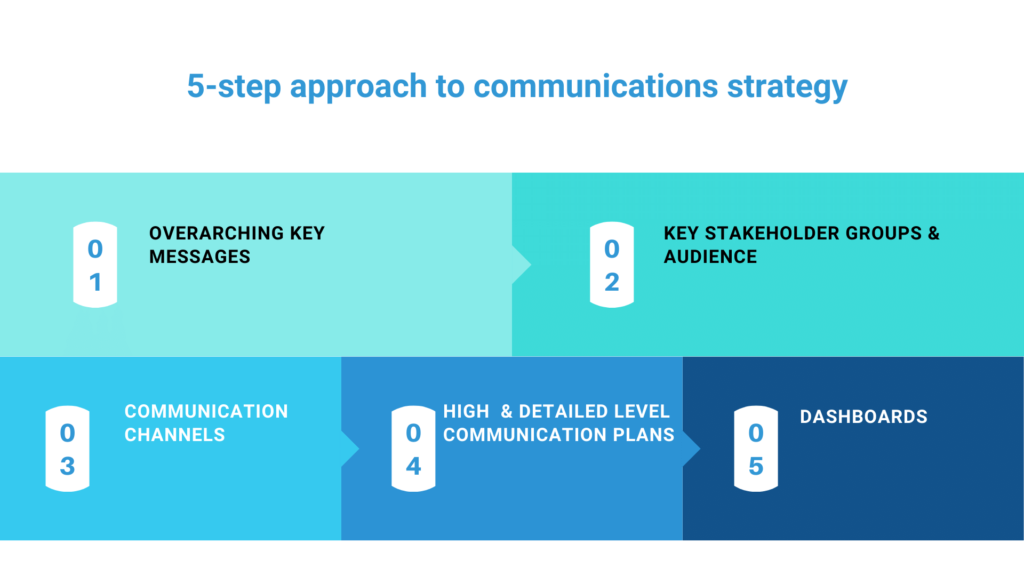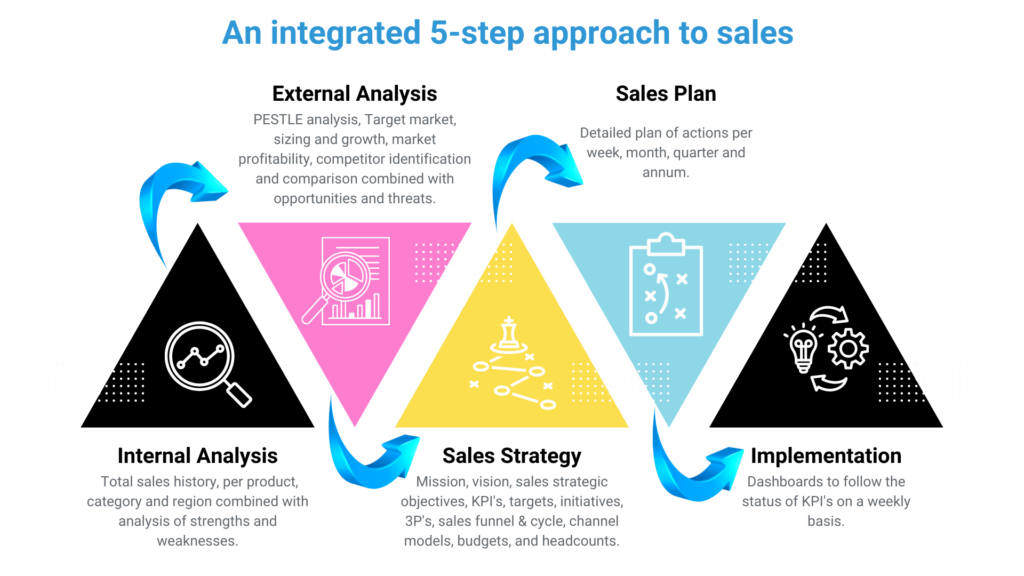
MarCom & Sales
Take for example social media. It offers businesses across industries tremendous opportunities to communicate with various stakeholders nearly instantly, 24/7, offering multitude of opportunities. On the flip side, social media can prove to be detrimental for businesses if not managed properly. We have all witnessed number of disastrous outcomes on reputations in the recent years!
To minimize communications risks while at the same time capitalizing on the multitude of opportunities, it is important to take an agile and robust approach to any communications strategy. We have helped number of clients across consumer-facing industries to develop nimble and comprehensive communications strategies using an effective 5-step framework.
5-step approach to communications strategy
Starting from high level, we first define the underlying communications strategy that uses various input metrics from the overarching marketing strategy. Here we define levers such as; background & context, communication objectives, KPI’s, overall approach, communication principles, overarching messages, key stakeholder groups, communication channels, key dependencies, communication risks & opportunities.
After this, a high level communications plan needs to be defined for each stakeholder group combined with a layer below, a detailed plan. No plan is successful unless it can be managed and tracked, hence appropriate and data-driven dashboards for tracking and managing progress need to be defined.

Get in contact with our MarCom & Sales practice area to learn more how we can lead and facilitate your communications strategy planning
Talk to usSales – the direct revenue generator
The third dimension of MarCom & Sales triangle is the direct revenue generator of nearly all businesses (besides some forms of Direct-to-Consumer business designs). Sales and its objectives are driven as inputs from comprehensive marketplace understanding – what are we offering and to who as an organization? Factors such as; value proposition, what products and/or services to what customer segments etc. play a significant role in defining the sales strategy and highlight the interconnectedness with marketing.
What is strategic sales?
Organizations often, mistakenly, look at sales simply from a perspective of delivering products and services to the marketplace using various tactical decisions. Simply put, this is just one component of sales discipline and far too narrow in scope. We strongly believe in a concept called strategic sales.
What is it? It consists of a detailed strategy that systematically drives sales plans and implementation through constant flow of information derived from data-driven understanding of the changes in the marketplace. Needless to say, today’s rapidly evolving marketplaces require that company’s develop agile and robust sales strategies.
Here in lies one of the biggest challenges that far too many organizations experience – the disconnectedness between marketing and sales disciplines due to often siloed organizational designs. As new technology and tools, such as big data and advanced analytics, enhance the firm’s understanding of marketplace dynamics, it creates internal forces for organizations to think about the interconnectedness of marketing and sales more holistically.
MarCom & Sales triangle offers an effective framework for organizations to develop this interconnectedness. By gathering and analyzing data about sales and customers together with marketing, sales managers can understand patterns and make strategic decisions about how best to meet company goals. To reach those goals, sales managers not only make decisions regarding strategic sales, but also motivate individuals and teams to put those strategies into action.
Learn more here how developing an organizational design can help break siloed “legacy” thinking.
Much of same skills required
Today’s requirement for MarCom and Sales professionals includes much of the same skill-sets and competencies, which some decades ago was not as paramount. What are these competencies?
- Understanding of predictive analytics.
- Strategic acumen.
- Ability to identify changes within competition and competitive landscape.
- Understanding and knowing the needs of customers and predicting changes.
- Developing, leading and nurturing competencies.
Agile sales strategy and planning
We advise and help organizations globally across industry verticals to improve on strategic sales development, planning, and implementation by utilizing an integrated 5-step approach.
1. Internal analysis
Internal analysis focuses on an in-depth analysis of firm’s sales history. Total sales history with CAGR (Compounded Annual Growth Rate) calculations, sales history per category, region, and product combined with an analysis of what the organization excels at and what differentiates it from the competition, and on the other hand analysis of factors that hinder or stop the organization from performing at an optimum level are all critical components of the internal analysis.
2. External analysis
The second step involves an external analysis. It draws much of its outcome from the use similar tools as with strategic marketing planning. Analysis tools such as PESTLE, market profitability, competitor identification and comparison, target market and market sizing (TAM, SAM etc.), and SWOT come to play significantly. It is important to note that in external analysis we draw number of data-points from the marketplace (industry specific) and form correlations with firm’s historical data.
3. Sales strategy
Once the internal and external environments have been fully analyzed in-depth, we move to developing sales strategy. Here sales strategic objectives are identified and they are, to large, extent drawn from the firm’s vision and mission as the strategic sales objectives should help the organization to achieve its mission and reach its vision. After defining strategic objectives, we define the rationale behind each objective combined with identifying KPI’s, targets, and initiatives. Key product categories and individual products (or services) are defined with pricing and promotion strategies (including tactical promotion(s) plan). Sales funnel process, sales cycle, and sales channel model with associated strategies combined with resources, budgets and headcounts are also pivotal.
4. Sales plan
After defining the strategy, tactical sales planning will be identified. This will include creating a robust plan of actions that span over a specified time periods, such as per month or quarter depending on the line of business.
5. Implementation
In the final step, we create a data-driven dashboard(s) that allows systematic follow-up of the accomplishment of sales strategic objectives and the associated sales KPI’s using, for example a “traffic light” format. The dashboard includes both a high and detailed level analysis, providing the sales leadership or C-suite professionals to drill down on specifics when needed.
It is also important to remember that the implementation phase should include a set-up procedures and processes for how to follow up on strategic objectives. Situations vary to large degree across organizations, however, we have found the following approach to be highly effective for number of SME businesses.
- Make sure everyone has a clear understanding of the different roles & responsibilities.
- Set up a 45-min weekly meeting with all the key stakeholders to follow the Sales Strategic Objectives progress.
- Display the dashboards on the meeting room. Choose a method that best suits your company, e.g.,:
- Print the dashboards on big A1 and stick them on the meeting room wall.
- Reproduce the dashboards using post-it notes etc.
- Use digital whiteboards such as Google Jamboard (effective for cross boarder teams)
- If the dashboard is automated with software, use associated presentation tools or sharing via Teams or other remote work process applications (effective for cross boarder teams).

